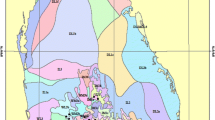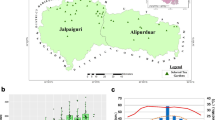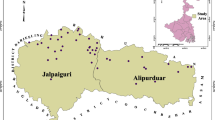Abstract
Based on phenological and economic output models established and meteorological data from 1972 to 2013, changes in the phenology, frost risk, and economic output of the Longjing-43 tea tree in the Yuezhou Longjing tea production area of China were evaluated. As the local climate has changed, the beginning dates of tea bud and leaf plucking of this cultivar in all five counties studied has advanced significantly by −1.28 to −0.88 days/decade, with no significant change in the risk of frost. The main tea-producing stages in the tea production cycle include the plucking periods for superfine, grade 1, and grade 2 buds and leaves. Among the five bud and leaf grades, the economic output of the plucking periods for superfine and grade 1 decreased significantly, that for grade 2 showed no significant change, and those for grades 3 and 4 increased significantly. The economic output of large-area tea plantations employing an average of 45 workers per hectare and producing superfine to grade 2 buds and leaves were significantly reduced by 6,745–8,829 yuan/decade/ha, depending on the county. Those tea farmers who planted tea trees on their own small land holdings and produced superfine to grade 4 tea buds and leaves themselves experienced no significant decline in economic output.






Similar content being viewed by others
References
Ahas R, Jaagus J, Aasa A (2000) The phenological calendar of Estonia and its correlation with mean air temperature. Int J Biometeorol 44(4):159–166
Ahas R, Aasa A, Menzel A, Fedotova VG, Scheifinger H (2002) Changes in European spring phenology. Int J Climatol 22:1727–1738
Avolio E, Orlandi F, Bellecci C, Fornaciari M, Federico S (2012) Assessment of the impact of climate change on the olive flowering in Calabria (southern Italy). Theor Appl Climatol 107(3–4):531–540
Badeck FW, Bondeau A, Böttcher K, Doktor D, Lucht W, Schaber J, Sitch S (2004) Responses of spring phenology to climate change. New Phytol 162(2):295–309
Cannell MGR, Smith RI (1986) Climatic warming, spring budburst and forest damage on trees. J Appl Ecol 23(1):177–191
Cheng TO (2006) All teas are not created equal: the Chinese green tea and cardiovascular health. Int J Cardiol 108(3):301–308
Chmielewsky FM, Roetzer T (2001) Response of tree phenology to climate change across Europe. Agric For Meteorol 108(2):101–112
Cittadini ED, Ridder N, Peri PL, Keulen H (2006) A method for assessing frost damage risk in sweet cherry orchards of South Patagonia. Agric For Meteorol 141:235–243
Cleland EE, Chuine I, Menzel A, Mooney HA, Schwartz MD (2007) Shifting plant phenology in response to global change. Trends Ecol Evol 22(7):357–365
Colombo SJ (1998) Climatic warming and its effect on bud burst and risk of frost damage to white spruce in Canada. For Chron 74(4):567–577
Cooper R, Morré DJ, Morré DM (2005) Medicinal benefits of green tea: part I. review of noncancer health benefits. J Altern Complement Med 11(3):521–528
General Administration of Quality Supervision, Inspection and Quarantine of the People’s Republic of China (2002) GB 18650–2002 Product of Designations of Origin and Geographical Indications—Longjing tea. China Standard Press: Peking, China.
Gerstengarbe FW, Werner PC (1999) Estimation of the beginning and end of recurrent events within a climate regime. Clim Res 11:97–107
Hänninen H (1991) Does climatic warming increase the risk of frost damage in northern trees? Plant Cell Environ 14(5):449–454
Howden SM, Soussana JF, Tubiello FN, Chhetri N, Dunlop M, Meinke H (2007) Adapting agriculture to climate change. Proc Natl Acad Sci U S A 104(50):19691–19696
Huang S (1989) Meteorology of the tea plant in China: a review. Agric For Meteorol 47(1):19–30
Jamieson RW (2001) The essence of commodification: caffeine dependencies in the early modern world. J Soc Hist 35(2):269–294
Jiang FQ, Hu RJ, Zhang YW, Li XM, Tong L (2011) Variations and trends of onset, cessation and length of climatic growing season over Xinjiang, NW China. Theor Appl Climatol 106(3–4):449–458
Julien Y, Sobrino JA (2009) Global land surface phenology trends from GIMMS database. Int J Remote Sens 30(13):3495–3513
Juszczak R, Kuchar L, Leśny J, Olejnik J (2013) Climate change impact on development rates of the codling moth (Cydia pomonella L.) in the Wielkopolska region, Poland. Int J Biometeorol 57(1):31–44
Kramer K, Leinonen I, Loustau D (2000) The importance of phenology for the evaluation of impact of climate change on growth of boreal, temperate and Mediterranean forests ecosystems: an overview. Int J Biometeorol 44(2):67–75
Kropff MJ, Laar HV, Matthews RB (1994). ORYZA1: an ecophysiological model for irrigated rice production. In: SARP Research Prooceedings. Wageningen: IRRI/AB-DLO, 110 p.
Li L, Ma J, Luo L, Wang X (2007) The spread of tea cultivar Longjing 43 in Zhejiang province and its economic benefit analysis. J Teach 33(1):38–40 (in Chinese)
Liang L, Schwartz MD (2013) Testing a growth efficiency hypothesis with continental-scale phenological variations of common and cloned plants. Int J Biometeorol 1–9
Linkosalo T, Häkkinen R, Hänninen H (2006) Models of the spring phenology of boreal and temperate trees: is there something missing? Tree Physiol 26(9):1165–1172
Lou W, Sun S (2013) Design of agricultural insurance policy for tea tree freezing damage in Zhejiang Province, China. Theor Appl Climatol 111(3–4):713–728
Lou W, Sun K, Sun S et al (2013) Changes in pick beginning date and frost damage risk of tea tree in Longjing tea-producing area. Theor Appl Climatol 114(1–2):115–123
Meinke M, Howden SM, Struik PC, Nelson R, Rodriguez D, Chapman SC (2009) Adaptation science for agriculture and natural resource management—urgency and theoretical basis. Curr Opin Environ Sustain 1(1):69–76
Menzel A (2000) Trends in phenological phases in Europe between 1951 and 1996. Int J Biometeorol 44(2):76–81
Roetzer T, Wittenzeller M, Haeckel H, Nekovar J (2000) Phenology in central Europe-differences and trends of spring phenophases in urban and rural areas. Int J Biometeorol 44:60–66
Scheifinger H, Menzel A, Koch E, Peter C (2003) Trends of spring time frost events and phenological dates in Central Europe. Theor Appl Climatol 74(1–2):41–51
Serba T, Lesny J, Juszczak R, Utset A, Eitzinger J, Olejnik J (2010). The adaptation of agriculture to climate changes—the point of view of Polish farmers. In: Lesny J (ed) Agrometeorology research. Acta Agrophysica 185: 70–86.
Sparks TH, Menzel A (2002) Observed changes in seasons: an overview. Int J Climatol 22(14):1715–1725
Stone R, Nicholls N, Hammer G (1996) Frost in northeast Australia: trends and influences of phases of the Southern Oscillation. J Clim 9:1896–1909
Tomihama T, Nonaka T, Nishi Y, Arai K (2009) Environmental control in tea fields to reduce infection by Pseudomonas syringae pv. theae. Phytopathology 99(2):209–216
van Vliet AJ, Overeem A, De Groot RS, Jacobs AF, Spieksma F (2002) The influence of temperature and climate change on the timing of pollen release in the Netherlands. Int J Climatol 22(14):1757–1767
Wang H, Wang B, Bao J (1981) Statistical methods of threshold temperature and accumulated temperature of Camellia sinensis sprouting in spring. Chin J Agrometeorol 3:65–70 (in Chinese)
Wolfe DW, Schwartz MD, Lakso AN, Otsuki Y, Pool RM, Shaulis NJ (2005) Climate change and shifts in spring phenology of three horticultural woody perennials in northeastern USA. Int J Biometeorol 49:303–309
Zaveri NT (2006) Green tea and its polyphenolic catechins: medicinal uses in cancer and noncancer applications. Life Sci 78(18):2073–2080
Zhejiang Tea Industry Association (2012) Annual tea industry development report of Zhejiang Province in 2011. China Teach 42(7):7–8 (in Chinese)
Acknowledgments
This paper was financially supported by a major agricultural grant from the Science Technology Department of Zhejiang Province, China (No. 2011C22082). This work was also supported by a 2013 disaster research fund from the People’s Insurance Company of China (Grant 2013B16).
Ethical standards
The experiments performed in this paper complied with the current laws of China.
Author information
Authors and Affiliations
Corresponding author
Rights and permissions
About this article
Cite this article
Lou, W., Sun, S., Wu, L. et al. Effects of climate change on the economic output of the Longjing-43 tea tree, 1972–2013. Int J Biometeorol 59, 593–603 (2015). https://doi.org/10.1007/s00484-014-0873-x
Received:
Revised:
Accepted:
Published:
Issue Date:
DOI: https://doi.org/10.1007/s00484-014-0873-x




